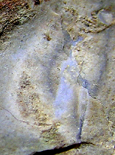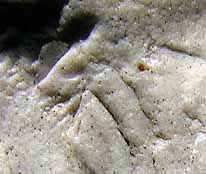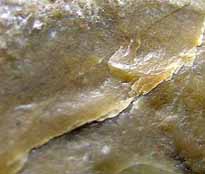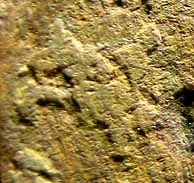|
 An ancient site in West-Central
Indiana (Photo)
contains projectile points, flaked chips, some so-called “microchips” and axe
heads, most with markings that do not seem to be attributable to Natural Causes. In this previously unglaciated site there
are also many stones with 3-10 cm. obviously carved shapes of humans and
animals, some resembling those of the Tlatilco, Mexico
area and possibly some primitive writings that are regularly accompanied by
carvings along their periphery. There is a trend for the earliest artifacts that depict animals and
humans to be smaller than later ones.
Frequent carvings of the American Lion (Panthera atrox), Horse and a Camelops
(Guanaco-like) point to the site dating back into the Pre-Classic
Period. Although recent discoveries
in the Southeastern United States show possible human habitation dating to
40,000 B.C.+ (see Savannah),
the cataclysmic asteroid bombardment of glacier-covered Eastern Canada around
10,000 BCE that may have caused the mass extinction of large herbivores and
their predators probably preceded the arrival of the Indiana inhabitants. With the exception of the American lion
and some elephantine creatures, no clear carvings of mammoths, rhinos, sloths
and other earlier extinct animals are represented even though there is conclusive evidence for the hunting by
humans during the Pleistocene (See: Mammoths, Camelids, & Lions). . The European appearance of the inhabitants
point to their possible origins in Southwestern Europe, which corresponds to
theories that such groups were the first to colonize North America. Their language could have been the Saharan
dialect proposed by Edo Nyland,
and this may account for the numerous Saharan names
(= present-day Basque) found widespread in America. For a description of the collection locality see Locality. Also view some Tools, and other Ancient
American Sites. Close-ups of figures may be viewed at the
following, but the images often blend in with the color of the substrate and
may not at first be clearly discernible.
Some figures of uncertain identity are included but may be removed
after closer analysis. Given the apparent ancient origins of the site, the
artifacts are nevertheless in remarkable states of preservation. An ancient site in West-Central
Indiana (Photo)
contains projectile points, flaked chips, some so-called “microchips” and axe
heads, most with markings that do not seem to be attributable to Natural Causes. In this previously unglaciated site there
are also many stones with 3-10 cm. obviously carved shapes of humans and
animals, some resembling those of the Tlatilco, Mexico
area and possibly some primitive writings that are regularly accompanied by
carvings along their periphery. There is a trend for the earliest artifacts that depict animals and
humans to be smaller than later ones.
Frequent carvings of the American Lion (Panthera atrox), Horse and a Camelops
(Guanaco-like) point to the site dating back into the Pre-Classic
Period. Although recent discoveries
in the Southeastern United States show possible human habitation dating to
40,000 B.C.+ (see Savannah),
the cataclysmic asteroid bombardment of glacier-covered Eastern Canada around
10,000 BCE that may have caused the mass extinction of large herbivores and
their predators probably preceded the arrival of the Indiana inhabitants. With the exception of the American lion
and some elephantine creatures, no clear carvings of mammoths, rhinos, sloths
and other earlier extinct animals are represented even though there is conclusive evidence for the hunting by
humans during the Pleistocene (See: Mammoths, Camelids, & Lions). . The European appearance of the inhabitants
point to their possible origins in Southwestern Europe, which corresponds to
theories that such groups were the first to colonize North America. Their language could have been the Saharan
dialect proposed by Edo Nyland,
and this may account for the numerous Saharan names
(= present-day Basque) found widespread in America. For a description of the collection locality see Locality. Also view some Tools, and other Ancient
American Sites. Close-ups of figures may be viewed at the
following, but the images often blend in with the color of the substrate and
may not at first be clearly discernible.
Some figures of uncertain identity are included but may be removed
after closer analysis. Given the apparent ancient origins of the site, the
artifacts are nevertheless in remarkable states of preservation.
|




